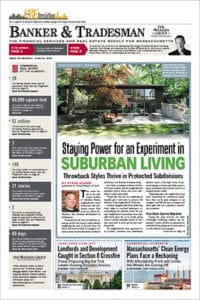Waterfront barriers, living shorelines and elevated roads from East Boston to Dorchester are key elements of Boston’s resiliency strategy to protect billions of dollars in real estate from rising seas.
The plan to fortify South Boston and the Seaport District includes an earthen berm along the east side of Fort Point Channel to protect 100 buildings including the future General Electric headquarters and Gillette Co. campus from inundation. One of the short-term priorities in Mayor Marty Walsh’s resilience plan has an estimated cost of up to $12 million. A new taller seawall on Seaport Boulevard is estimated at up to $22 million. Neighborhood-wide projects throughout South Boston could cost $1 billion in coming decades.
“People have been asking, `What’s Boston’s plan? What’s Boston’s plan?’ This pulls it all together under one roof,” Walsh said in releasing the latest in a series of coastal resilience plans for waterfront neighborhoods.
The city will seek to split the cost with state and federal sources, nearby private land owners and donors, Walsh said. Specific funding sources have not been identified, but Walsh said the city’s $230-million capital budget will increase by up to $20 million. No new taxes or assessment districts are being proposed, but the city expects that property owners and foundations will contribute, Walsh said.
“There’s a lot at stake for businesses and the people who work there,” he said.
But Boston-based Conservation Law Foundation said it’s unrealistic to expect that private developers, with their typically short-term investment horizons, will pay for long-term solutions.
“As much as the city would like for a lot of this investment to be raised voluntarily, at some point there probably needs to be some mandated contributions so we don’t have a free-rider problem,” said Deanna Moran, CLF’s director of environmental planning. “The merchant developers who buy, build and sell are harder to engage, especially in these longer-term strategies.”
A report this year by UMass-Boston’s Sustainable Solutions Lab pointed to several models for public-private financial partnerships to pay for climate change protection. The options include district improvement financing bonds, a business improvement district similar to the one recently created for the Rose Fitzgerald Kennedy Greenway, and a “resilience district” that could collect fees on property owners and potentially commercial tenants and residents.
“The burden shouldn’t fall on the city and taxpayers to bail out the waterfront, especially new construction that was aware of the risks,” Moran said.

Steve Adams
Building in the Path of Flooding
In South Boston, the initial projects would protect the 100-acres planning district near the future General Electric headquarters and a 6-acre parcel that Gillette Co. recently put on the market, as well as a section of Seaport Boulevard that has flooded in recent Nor’easters.
The citywide strategy calls for barriers and living shorelines that can absorb flood waters, along with plans to elevate major arteries prone to frequent flooding such as Morrissey Boulevard. The new barriers would protect areas being actively eyed for future development, such as Widett Circle and the former Bayside Expo property.
The opportunity for shore-based protection measures comes after a UMass-Boston study this year rejected the idea of building a nearly $12-billion, 3.8-mile barrier across the mouth of Boston Harbor as too expensive and ineffective.
The South Boston coastal resilience plan recommends a series of district-wide defenses, in contrast to a piecemeal approach by individual property owners. Based upon projections of sea levels rising by 40 inches by 2070, severe storms could cause over $8 billion in damage to properties in Boston, the report concludes.
Winter storms in recent years have sent floodwaters down streets of Fort Point and the Long Wharf area, inundating the MBTA’s Aquarium station and threatening to spill down highway ramps into the Central Artery Tunnel system.
The report was developed by the city’s Green Ribbon Commission with support from the Barr Foundation, which has contributed nearly $5 million toward local climate planning initiatives over the past five years.
“The financing of this is the next important step. It’s all-hands-on-deck for sources to come together – public, private and philanthropic – to address some of the needs that were laid out,” said Jim Canales, president of the Barr Foundation. “One would hope any developer would care not only about their own opportunities, but a broader context. That’s more of a moral incentive, but it’s an important one.”





